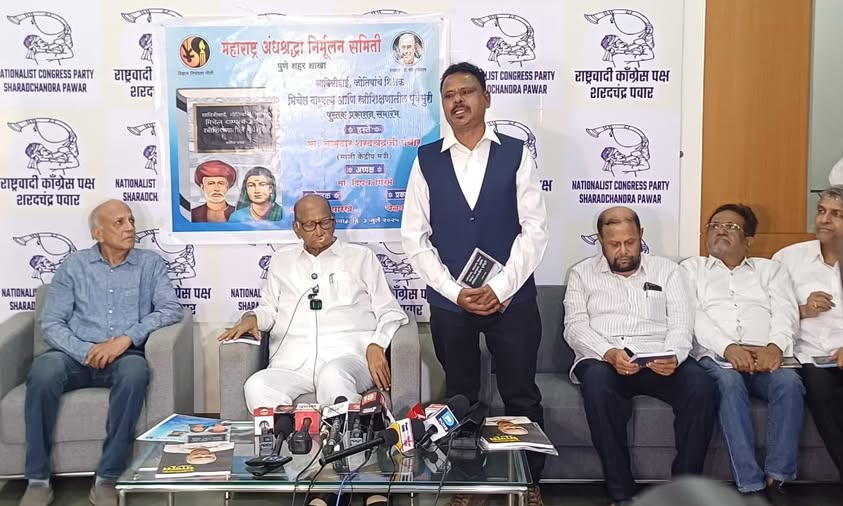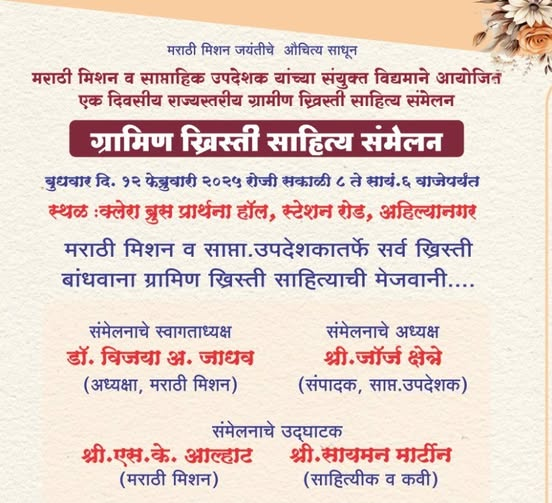सावित्रीबाई आणि जोतिबांच्या आजही कायम राहिलेल्या काही पाऊलखुणांपैकी एक असलेली पुणे कॅम्पातील घाशीराम कोतवालच्या मध्ययुगीन गढीच्या अगदी समोर असलेली ही सेंट मार्गारेट मराठी प्राथमिक शाळा.
सावित्रीबाई आणि जोतिबाचे शिक्षक दाम्पत्य असलेल्या मार्गारेट आणि जेम्स मिचेल या स्कॉटिश मिशनरींचे इथेच वास्तव्य होते, येथील आवारातच फुले दाम्पत्याने शिक्षण घेतले याविषयी आता शंका नसावी
सत्तरच्या दशकात विजया श्यामराव पुणेकर सेंट मार्गारेट प्राथमिक शाळेच्या मुख्याधिपिका होत्या. नंतरच्या काळात त्या मुंबईतील जॉन विल्सन एज्युकेशन सोसायटीच्या सेंट कोलंबा गर्ल्स हायस्कुलच्या आणि पुण्यातीलच एथेल गॉर्डन अध्यापन विद्यालयाच्या प्राचार्य होत्या.
जॉन विल्सन एज्युकेशन सोसायटी म्हणजेच पूर्वीचे स्कॉटिश मिशन.
मुंबईत १९९० साली भरलेल्या चौदाव्या मराठी ख्रिस्ती साहित्य संमेलनाचे विजया पुणेकर यांनी अध्यक्षस्थान भूषवले होते.
विजया पुणेकर यांनी सेंट मार्गारेट प्राथमिक शाळेचा अगदी जुना तसेच गेल्या काही दशकांचा इतिहास संक्षिप्तपणे लिहिला आहे.
अर्थात या लेखात सावित्रीबाई आणि जोतिबा फुले यांचा नामोल्लेखदेखील नाही.
स्कॉटिश मिशनच्या म्हणजेच मुंबईत मुख्यालय असलेल्या जॉन विल्सन एज्युकेशन सोसायटीच्या पुण्यातील चारही शाळा सावित्रीबाई आणि जोतीबांचा या शाळेशी असलेल्या निकट संबंधांबद्दल आजही पूर्णतः अनभिज्ञ आहेत.
सन १९८२च्या डिसेंबर महिन्यात प्रकाशित झालेल्या विजया पुणेकर यांच्या लेखातील काही मजकूर पुढीलप्रमाणे आहे:
स्कॉटिश मिशनची पुण्यातील पहिली शाळा-सेंट मार्गारेट स्कूल अँड चिल्ड्रेन्स होम
भारतातील शैक्षणिक संस्थांच्या इतिहासाचे अवलोकन केल्यास स्कॉटिश मिशनरींनी सुरू केलेल्या संस्था दीर्घकाळपर्यंत भव्याहतपणे चालू राहिलेल्या आहेत असे आदळते.
तसेच या संस्थांनी सुरुवातीच्या काळात प्राप्त केलेला उच्च शैक्षणिक दर्जा आजतागायत राखलेला आहे हेही लक्षात घेण्यासारखे आहे.
१८२३ साली स्कॉटिश मिशनरी सोसायटीतर्फे पाठविलेले पहिले मिशनरी रेव्ह. डॉनाल्ड मिचेल पश्चिम भारतात आले. केवळ दहा महिन्यांच्या अवधीत त्यांनी कोकणात दहा शाळा सुरू केल्या.
त्यांच्यानंतर आलेल्या मिशनरींनी १८२७ सालाअखेर ८० शाळा सुरू केल्या होत्या. त्यांपैकीच एक शाळा पुढे सेन्ट मार्गारेट शाळा म्हणून ओळखली गेली.
डॉ. जॉन विल्सन हे अष्टपैलू व्यक्तिमत्व असलेले स्कॉटिश मिशनरी १८२९ साली आपल्या पत्नी मार्गारेट यांच्यासमवेत पश्चिम भारतात कार्य करण्यासाठी आले.
अगदी थोड्या अवधीत त्यांनी अनेक भाषा आत्मसात केल्या. स्त्री-शिक्षणाची आवश्यकता विल्सन दांपत्याला पुरेपूर पटलेली होती. त्यांनी प्रथम कोकणात, नंतर मुंबईत मुलींच्या शाळा सुरू केल्या.
त्याच सुमारास पुणे या ठिकाणी रेव्ह. जेम्स मिचेल भाणि त्यांच्या पत्नीची मिशनरी म्हणून नेमणूक झाली होती. १८४० साली पुण्यामध्ये मुलींच्या एकूण पाच शाळा मिचेल दांपत्य चालवित होते.
त्यानंतर १८४१ साली मिसेस् मिचेल यांनी मार्गारेट विल्सन यांनी सुरू केलेल्या बोर्डिंग स्कुलच्या धर्तीवर स्टेनली रोड या ठिकाणी आपल्या राहत्या बंगल्यात एक बोर्डिंग सुरू केली.
तिला सेन्ट मार्गारेट स्कुल असे नाव देण्यात आले.
मिसेस जेम्स मिचेल स्कॉटलंडदेशी १८६६ साली गेल्यानंतर काही काळ मिसेस (जॉन) मरे मिचेल आणि नंतर मिसेस अँगस आणि मिसेस गार्डनर यांनी शाळा व वसतिगृह यांचे कामकाज पाहिले.
१८६६ साली मिसेस गार्डनरच्या काळात सध्याची शाळेची इमारत बांधली गेली.
स्कॉटलंडमध्ये वार्षिक सेल भरवून स्त्रियांनी ही इमारत बांधण्यासाठी आर्थिक साहाय्य मिळविले होते.
१८७२ साली मिसेस बिमॉन्ट यांनी बोर्डिंगची जबाबदारी उचलली. मिसेस मिलर, मिस स्मॉल या मिशनरींनी १८८९ पर्यंत बोर्डिंगचे व इतर काम पाहिले. त्यानंतर मिस पॅक्स्टन आणि मिस लिजरवूड या मिशनरींनी 'पूना विमेन्स वर्क' आणि सेन्ट मागरिट स्कूल आणि बोर्डिंगची जबाबदारी स्वीकारली.
त्यांच्यानंतर अनेक वर्षे या शाळेत काम केलेल्या मिशनरी म्हणजे जेन टेलर. पूर्वी त्या मिस वॉट म्हणून ओळखल्या जात. त्यांची कारकीर्द मोठी होती.
सगुणाबाई भिंगारदिवे या मेट्रनबाईचे त्यांना मोठे सहकार्य मिळाले. विल्सन कॉलेजच्या डॉ. टेलर यांच्याशी त्यांचा विवाह झाल्यानंतर त्यांच्या जागी सगुणाबाईच्या कन्या मालतीबाई भिंगारदिवे शाळेच्या प्रमुख झाल्या.
तत्पूर्वी त्या सेंट अँड्र्यूजमध्ये शिक्षिका दोत्या. सखूबाई आढाव आणि कमळाबाई कोहाळकर यांनीही या शाळेत अनेक वर्षे मेटूनचे फाम केले.
या शाळेचे वैशिष्ट्य म्हणजे कोर्ट कमिटेड आणि अनाथ मुलांसाठी वसतिगृह चालविणे हे होय. जुनी इमारत असूनही मुलींना जास्तीत जास्त सुखसोयी करून दिल्या गेल्या आहेत.
मालतीबाईंच्या काळात एक नवीन डॉर्मेटरी आणि वर्गासाठी दोन खोल्या बांधल्या गेल्या. त्या शिस्तप्रिय आणि उच्च शैक्षणिक दर्जा राखणाऱ्या म्हणून लक्षात राहतील, कृपाबाई पंडित काही काळ शिक्षिका होत्या. नंतर त्या मेट्रनचे काम पाहत.
कृपाबाई कदम या थर्ड इयर उत्तीर्ण झालेल्या शिक्षिकेने दीर्घकाळ तेथे अध्यापन केले. तसेच मेरीबाई गेटस, गेनूबाई शिंदे, मनुबाई पंडित, लीला सेडकर, विमल चव्हाण, गंगूबाई गायकवाड व पद्मा जाधव यांनीही अनेक वर्षे या शाळेत ज्ञानदानाने कार्य केले आहे.
चर्च ऑफ स्कॉटलंड मिशनचे पौड या ठिकाणी असलेले अनाथाश्रम बंद करण्यात येऊन तेथील मुले, मुली आणि मेट्रन्स या सर्वांना मागरिट शाळेत आणि वसतिगृहात राहण्यास आणले गेले, त्यावेळी कमळापाई कोहाळकर पौडहून पुण्यास आल्या.
मालतीबाईंनी पुण्यातील स्कॉटिश मिशनच्या अनेक संस्थांतून सेवा केली, परंतु त्यांची सेन्ट मार्गारेट शाळेतील सेवा सर्वांत वाखाणण्यासारखी आहे. त्यांचा शांत आणि प्रेमळ स्वभाव सर्वांची मने जिंकून घेई. त्यांनी शाळेच्या हेडमिस्ट्रेस म्हणूनही काम पाहिले आणि शैक्षणिक दर्जा उच्च प्रतीचा राखला.
मालतीबाईंच्या नंतर माणिकबाई पारधे शाळेच्या प्रमुख म्हणून नेमल्या गेल्या. त्यांना बेने इस्राएल शाळेत शिक्षिका, मुख्याध्यापिका आणि ट्रे. कॉलेज वसतिगृहप्रमुख अशा विविध कामांचा अनुभव होता. त्या १९६४ साली प्रमुख झाल्या. त्यावेळी शाळेत इ. १ ते ७ वीचे एकूण ११ वर्ग होते.
१९७१ सालापासून ५ ते ७ या इयत्ता दरवर्षी एक याप्रमाणे कमी केल्या गेल्या. सध्या १ ते ४ इयत्ताच असल्या तरी वसतिगृहात ८२ विद्यार्थिनी आहेत.
वसतिगृहाच्या कामाला या संस्थेत अधिक महत्त्व दिले जाते. सध्या ७५ कोर्ट कमिटेड आणि ७ खाजगी विद्यार्थिनी आहेत.
कोर्ट कमिटेड मुलींसाठी समाज कल्याण खात्याकडून प्रत्येकी मासिक ६५ रु. विद्यावेतन मिळते. भोजन, कपडे, वह्या, पुस्तके, अंथरुण, पांघरुण यासाठी हे अपुरे पडते. तेव्हा ही आर्थिक तूट स्कॉटलंड मिशनकडून मिळणाऱ्या विशेष अनुदानाने भरून काढली जाते.
माणिकवाई पारधे मुलींच्या वैयक्तिक गरजांकडे जातीने लक्ष पुरवीत, वसतिगृह घरासारखे वाटावे म्हणून त्या प्रयत्नशील असत. काही काळ त्यांनी शाळेच्या हेड-मिस्ट्रेसचेही काम पाहिले. ५ ते ७ या इयत्ता बंद केल्यामुळे मोकळ्या झालेल्या खोल्यांचा उपयोग सभा-संमेलनासाठी होई. या कामागाठी माणिकबाईंच्या अनुभवाचा उपयोग झाला. मिस बायर्स यांचेही त्यांना काही वर्षे सहकार्य लाभले.
१९७५ सालापासून सौ. मनोरमा ठाकूर यांनी माझ्या (विजया पुणेकर यांच्या) मार्गदर्शनाखाली हेडमिस्ट्रेसच्या कामाची जबाबदारी स्वीकारली,
पुणे शहरातील मिशनच्या अनेक प्राथमिक शाळांतून त्यांनी काम केले होते. शाळेच्या कामात सरकारी धोरणाप्रमाणे झालेले बदल समजून येऊन त्यांनी काम केले, त्या मे १९८२ मध्ये सेवानिवृत्त झाल्या.
वसतिगृहाच्या कामातून त्यापूर्वी १९८१ मध्ये मानिकबाई सेवानिवृत्त झाल्यावर कु. मंगला सोनतळे यांच्यावर वसतिगृह आणि केंद्र यांच्या कामकाजाची जबाबदारी सोपविण्यात आली. हे जबाबदारीचे आणि त्यांच्यासाठी नवीन असे काम त्या आत्मसात करण्याचा प्रयत्न करीत आहेत.
१९८२ सातापासून कु. मार्याबाई सूर्यवंशी मुख्याध्यापिका झाल्या आहेत, सुदिना चक्रनारायण, कमल देठे आणि सरोज क्षीरसागर या त्यांच्या सहाय्यक शिक्षिका आहेत. शाळेत सध्या (१९८२ साली) २१७ मुले आहेत.
जुलै १९८२ मध्ये सेन्ट कोलंबा स्कूल (मुंबई) या ठिकाणी माझी (विजया पुणेकर यांची) नेमणूक झाल्यापासून श्री. मोहन कोतवाल, सेन्ट जॉन स्कूलचे मुख्याध्यापक, या शाळेचे मॅनेजर म्हणून काम पाहत आहेत.''
पुण्यातील, महाराष्ट्रातील आणि संपूर्ण भारतातली एक सर्वांत जुनी आणि आजतागायत चालू असलेली ही सेंट मार्गारेट बालवाडी आणि मराठी प्राथमिक शाळा उद्या शनिवारी सकाळी डिसेंबर २० रोजी आपला वार्षिक दिन साजरा करत आहे
Camil Parkhe





